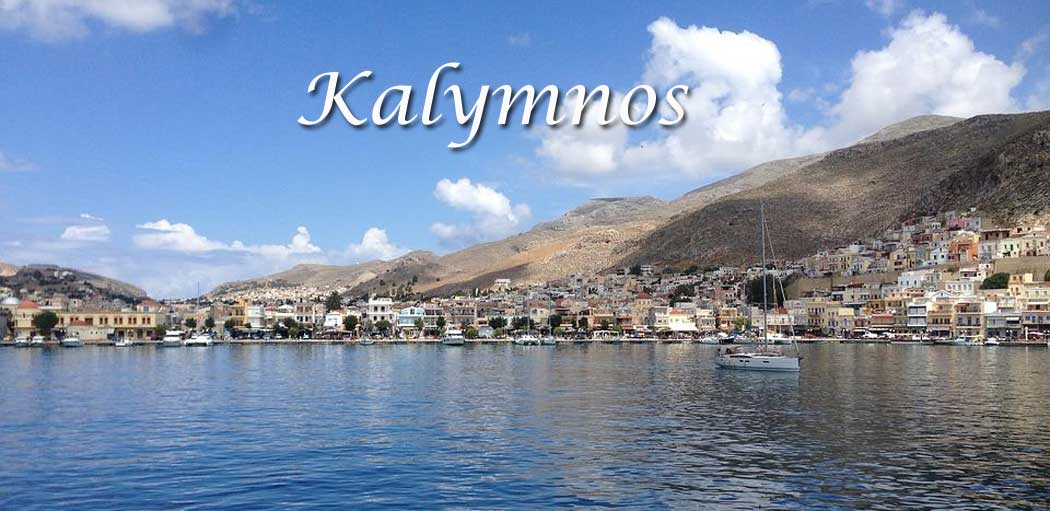Information about the island of Kalymnos Greece
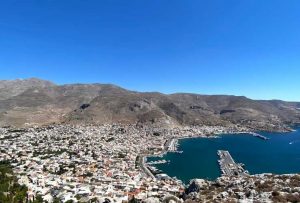
The capital of Kalymnos is the seaside town of Pothia, where most of the inhabitants are concentrated. It has been the center of administration and social and economic life of the island for the last 200 years. Here are all the public services and the commercial center of the island.
The port is located in the settlement of Pothia, on the southeast side of the island and is considered one of the most important ports in the country, because it is large, protected and has an important infrastructure. It is reached daily by large trucks and passenger ships.
Tourism is starting to take over as the main money generator these days but the island has managed to retain much of its Greek charm and age-old traditions. Most tourists by-pass Kalymnos in favour of nearby Kos.
Those who stop off here as part of their island hopping tour will find rugged mountainous scenery interspersed with fertile valleys, some of the finest fresh fish tavernas in the archipelago and lovely unspoilt beaches, some of which can only be accessed by boat.
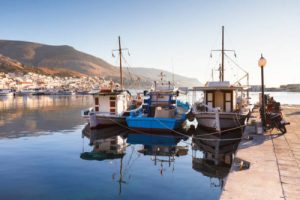
If you visit in the spring when the divers are about to set sail on their seven-month sponge fishing tour you’ll be able to join in the elaborate send-off which involves much feasting, dancing, general merrymaking and more than a few tears shed by wives and girlfriends.
Beyond the capital you’ll find starkly beautiful mountains which are a magnet for rock climbers, lush valleys carpeted with vines, lime and mandarin trees, pretty fishing harbours and some awe-inspiring stalactite caves.
The west coast has a couple of busy beach resorts geared to the needs of the package holiday market. From here you can take an excursion boat over to the striking, traffic-free islet of Telendos which was separated from Kalymnos by a cataclysmic earthquake in 554 AD.
The island’s capital is squeezed between steep grey mountain slopes in the south-east of the island and the ferry sails in past cement works and other industrial eyesores.
The town is colourful and lively amphitheatre built around the harbour with a complex of public buildings at the centre of the waterfront.
The posh end lies to the south, full of tourist shops, bars, hotels and yachts while the more interesting northern area has a market, traditional fish tavernas and booze shops.
Wherever you are in Pothia expect lots of noise. This is a busy place, with a reputed 6,000 motorbikes and most of them whining along the sea front or growling down side streets.
Apart from a dual carriageway that skirts the shoreline, Pothia’s streets are a narrow maze of bars, cafes, pool halls and bike shops. It’s easy to get lost in back streets lined with crumbling neoclassical houses, many with extraordinary wrought iron balconies.
An Archaeological and Folk Museum sits on the northern hillside and the Nautical Museum at the west end of the port with details of the lives of Pothia sponge divers.
About Kalymnos
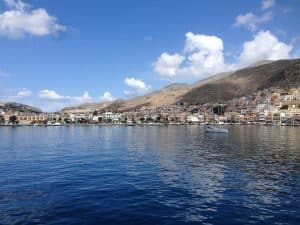
The capital and largest port of the island is Kalymnos or Pothia, as it was called until 1951. During your vacation in Kalymnos, do not miss visiting the rest of the island’s settlements, especially Emporio and Vathi, with the beautiful ” Rina’s fjord.
As soon as you arrive at the port of Kalymnos, the beautiful capital of the island, Pothia, you are greeted by a beautiful settlement, built amphitheatrically between two mountains. Stroll through its narrow streets with colorful houses, old mansions and captains’ houses, with the architectural influence of its Italian conquerors evident.
In Kalymnos you will find impressive sights of historical interest. On the steep hill above Chora dominates the Monastery of All Saints, while on the beach you will see the Cathedral of the island, the church of Sotiros Christos, with the impressive marble iconostasis, the work of the sculptor Giannoulis Halepas, while it is worth a visit to the church of Agios Nikolaou and in the Sanctuary of Delios Apollo.
Visit the Maritime Museum of Kalymnos where you will learn a lot about the maritime history of the island and the tradition of sponge making, the Archaeological Museum with the bronze female figure of the “Lady of Kalymnos”, but also visit the Valsamidis Museum of Marine Artifacts in Vlychadia, where you will meet a rare collection consisting of marine finds.
On the way to Vlychadia you will come across the Kalymnos House, a representation of a traditional house of the 19th century, a private folklore museum, which will convey to you the Kalymnic way of life, the living history of the traditional house, the main daily activities, social events and of course the epic life of Kalymnius the sponge.
It is worth going to the large Byzantine Castle of Chora with the small churches and admire the wonderful view from above, but also to the Venetian Castle of Chrysocheria, which was built in the 15th century and houses the church of Chrysochera Panagia.
Along the coast, you will wander the street full of tavernas to taste the traditional flavors and seafood.
Kalymnos has many beaches for all tastes, with sand or pebbles, organized or secluded, all of them have crystal clear blue waters and offer unforgettable moments of relaxation.
Swim in the crystal waters of the quiet Linaria beach, in the famous Platy Gialos with black sand and clear blue waters, but also in the most popular and organized Masouri beach, with a wide sandy beach, crystal clear waters and a view of Telendos. Get to know the beaches of Vlychadia, Myrties, Arginonta, Therma.
If you like action, the island has great hiking trails, as well as the possibility to visit about 50 caves, while every two years the Kalymnos Climbing Festival is organized, an international meeting of non-competitive climbers, like the Kalymnos Diving Festival, during which offers a full program of activities for those who love free and autonomous diving.
Geographic facts
Kalymnos shows intense fragmentation due to tectonic activity, which results in the creation of a large number of bays, capes, mountain masses and valleys.
Its terrain is mainly mountainous, but of relatively low altitude, with four main mountain ranges. The southern mountain range with the highest peak Merovivli (498m) is wide and low, the eastern with the highest peak Koukula (609m) and with a focal point Mondo Rito (405m), the northern with higher peaks Galatiani (590m) and Patela (433m) is longer, rough and desolate and the central one which is the steepest with the highest peak Prophet Ilias (676m).
Three important valleys form between the mountain ranges. This is the valley of the Pothia-Chorio region, the valley of Vathi, which hosts most of the inhabitants of Kalymnos, and the valley of Panormos.
The plain of Vathi lies to the east, is fertile with plenty of groundwater and maintains a sparse settlement system. The settlements of Vathys, Mavros Kipos, Metohi, Platanos, Rina, Stenoma and Stemenia spread from north to south. The end of the valley meets the sea at the edge of an impressive narrow bay.
The plain of Pothia, which is located to the west, although it is smaller, gathers the most inhabitants, because of the port. On the axis of the valley are built two large settlements, Pothia and Chora or Chorio.
Its coastline is highly indented with steep shores, many headlands, deep bays and harbors. The most important bays are of Aktis (Nachtis, Halis), Arginota, Vlychadia, Emporio, Linaria, Palaionisos, Pezonta, Pothia, Rina which is the port and Sykatis. The major capes around the island are Agios Georgios, Aspropoundari, Atsipas, Kefala, Kastelli, Katsouni, Pittaridia where there is also the Leros channel, Pounta (Skrini), Trachilos, Hali and Chondri Myti.
History of Kalymnos
Kalymnos has been inhabited since the Neolithic era. The oldest inhabitants of the island were the Kares who came to Kalymnos from Asia Minor at the beginning of the geometric era.
Homer calls it Kalydnes and mentions that the island participated in the Trojan War by sending together with other islands 30 ships led by Pheidippus and Antiphon.
After the Trojan War (according to Diodorus), four of Agamemnon’s ships sank on their return.
Their crews settled permanently on the island of Kalymnos nd built a settlement on the plateau of the island, which, in memory of their distant homeland, was named Argos. For a long time Argos was the capital of the island.
Apollo was the patron god of Kalymnos, while his sanctuary was its political and religious center throughout antiquity, from the beginning of the 1st millennium BC until the first Christian centuries.
In the 6th century BC, Kalymnos minted silver coins, depicting the head of a bearded helmeted warrior on the obverse and the lyre of the god Apollo on the reverse.
During the Persian Wars (early 5th century BC) the island was occupied by the Persians and Queen Artemisia the Elder. It was liberated in 477 BC, became a member of the Athenian Alliance, along with Lesvos, Chios, Samos, Kos and Rhodes and paid taxes to the alliance fund located in Delos.
Kalymnos does not seem to take part in the Peloponnesian War, since Thucydides does not mention it at all among other islands. In 357 BC. Kalymnos ceases to be free. It submits to the power of the king Mausolus. After about 15 years, Kalymnos revolts, gains its freedom and becomes an ally of the Athenians again.
During the 3rd century BC, Kalymnos minted silver and bronze coins, which have a rude helmeted warrior head on the front and a guitar on the reverse.
During Hellenistic times the island was often involved in extermination struggles between Alexander’s successors, due to its geographical location.
In fact, at this time forts and prisons were built in various parts of Kalymnos, for the protection of the inhabitants, due to the unstable socio-political conditions of the time.
At the end of the 3rd century BC Kalymnos and the neighboring island of Kos were united under the common state regime of the Federation.
Kalymnos was subjugated to the Romans in 44 BC. Read more about the History of Kalymnos.
Economy of Kalymnos
The economy of Kalymnos is mainly based on fishing and tourism. The primary sector includes agriculture, animal husbandry, fishing, beekeeping and sponge farming. The secondary sector does not have particularly important activities to show and is mainly the crafts and the PPC factory. The tertiary sector is mainly tourism, retail trade, transport, banking and various services.
Agriculture
Agricultural land occupies a small percentage of the island’s land and is not particularly developed. Nevertheless, the soil of the Vathi valley is quite fertile and several acres are cultivated, mainly with olive trees, citrus fruits and vegetables. Smaller crops are also found in the area of Panormos and the Argos plateau, where vines, olives, citrus fruits and vegetables are grown.
In the valley of Pothia, very small crops are cultivated, mainly horticultural crops, which are, however, used for family consumption and rarely for economic exploitation. In general, the lack of resources on the island does not favor the development of large farming units, with the result that the island is not self-sufficient and has to import agricultural products, mainly from neighboring Kos.
Livestock
Although the greater area of the island is covered by pastures, animal husbandry is not developed. The main animal husbandry activity is shepherding sheep and goats. The production of dairy products is limited to relatively small, mainly family businesses.
Fishing
Fishing is highly developed in Kalymnos and its fishing fleet is one of the largest in Greece. It holds the first place in the coastal and middle fishing in the Dodecanese, with swordfish fishing being important. In Kalymnos there are 8 fish farming units with an annual production of 1000-1200 tons of bream and a fry production unit.
Sponges
Sponge-making was until the beginning of the 20th century the island’s main source of wealth, making it known as the “island of spongers”. In the late 1980s, a disease that affected sponges significantly reduced production, and combined with the exclusion of sponges from the African coast, sponge-making in Kalymnos was in a significant decline. Today there are two sponge farms in Kalymnos, one in Kastelli and the other in Kambi, where the sponges are processed, traded and exported. At the natural sponge workshops on Pothia’s waterfront, you can see their processing process and get a souvenir.
Beekeeping
Particularly developed is beekeeping, which produced the wonderful thyme honey, famous since ancient times.
Industry and craft
The only industrial unit on the island is the Electric factory. The most important crafts are the boat repair and construction facilities in the carnagio (traditional wooden boat yards) that also serve the surrounding islands. Also important are the processing and maintenance units for natural sponges, as well as the plastic sponge shredding industry.
What to see in Kalymnos
Archaeological Museum
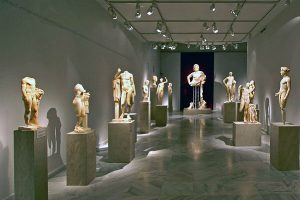
The museum, which covers an area of 1,000 square metres , is found in the Agia Oriada district of Pothia, and is housed in a two-storied mansion house donated by the Vouvalis family. It has a good collection of significant artefacts and archaeological finds all beautifully displayed.
The interior is a reconstruction of a typical 19th century mansion house with dining room, living-room, storerooms, service rooms and the Vouvalis family photographic archives on account of they are the ones who donated the building.
The courtyard outside has some marble pillars and various statues while the ground floor has many artefacts, some dating from as early a 5,000 BC. The first floor has any amount pottery and china, some very good paintings and statues and busts galore. Among the best exhibits are a statue of Isis, and marble heads of Aphrodite and Ygeia.
Maritime Museum
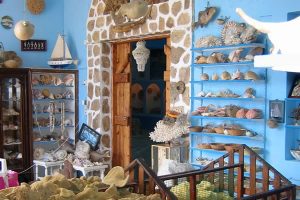
There are showcases packed with sponges, shells and corals. You can also see the wreck of an ancient ship, amphorae, stuffed fish and various of finds from the sea bottom
Virtually all the exhibits were collected by former sponge diver Kostas Valsimades who is often on hand to show visitors around the museum.
Sanctuary of delios Apollo
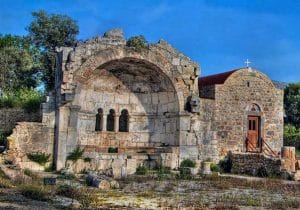
The sanctuary was the political and religious center of ancient Kalymnos and included religious and public buildings, which were erected between the 4th and 3rd centuries. BC Abundant finds, inscriptions, statue bases, vase fragments, figurines testify to the uninterrupted use of the space as a cult center. Besides the temple of Apollo, there was also a temple of Asclepius. However, apart from the religious buildings, there was a gymnasium, a parliament building and a theater.
According to the archaeological findings, the religious use of the area starts from the beginning of the 1st millennium BC and reaches the Early Christian era, when two large Christian churches were erected on the site, Christ of Jerusalem and Hagia Sophia.
Church of Panagia Charitomeni
It was once the metropolis of the island. It was built in the 18th century from the building materials of the ancient temple of Delios Apollo. You will be impressed by the wood-carved golden iconostasis of the early 19th century and its post-Byzantine icons.
Kalymnos House
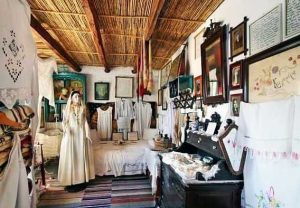
In this private folklore museum you will have the opportunity to admire exhibits of the popular culture of the area as well as objects of daily use.
It is a private Folklore Museum with objects of folk culture and household goods of old households. Here the visitor has the opportunity to experience the form and organization of life in a traditional urban house of the late 19th and early 20th centuries.
You will see a faithful representation of various parts of the house with period furniture, from the the bride’s bedroom and the kitchen to the kneading or laundry areas and the the family raised bed.
Castle of Chora
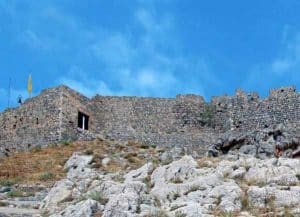
Walls and buildings are built of the same stone as the rocky peak, so that from a distance they appear as a continuation of the natural rock.
The position of the castle, in addition to the security it provided, also served to control the surrounding area and the maritime space. In fact, the placement of viglators (scopes) on other heights of Kalymnos, such as Merovigli and Vigles, helped in this project.
Sites of enviromental interest
Caves
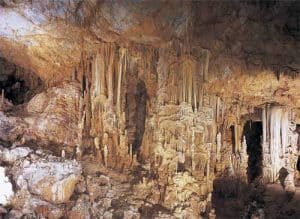
The cave of Kephala, to the southwest, a site of interest for archaeologists and speleologists. The main corridor extends along 103 m, featuring some sizeable stalactites. Oceanographer Anastasios Christomanos was the first man to explore the premises. There have thus been unearthed elements suggesting the place was used for the cult of the Olympian Zeus. Accessible by boat from Pothia or Myrties.
At Vathy you can visit the cave of Daskalio where various prehistoric findings have been unearthed – amongst which tools, flywheels – as well as ceramic works dating from the Minoan and Late Minoan era (years 2000 – 1400 BC).
The cave has been used by Kalymnians for defense purposes on various occasions, a use justified by the strategic location of the premises at the very mouth of the port. Difficult to accede (5 minutes by boat).
Also interesting are the caves of primitive dwelling, situated at the slopes of the Klastani and Tsingoura hills. There have been traces of smoke detected on the ceiling of such caves. More caves of this kind may be found in the area around the small church of Aghios Ioannis, although access thereto is rather difficult.
What to do
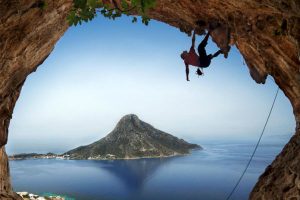
It is one of the most densely populated islands in Greece, even though its size is moderate and it is surrounded by many small islands, some inhabited and some uninhabited, everything you need for excursions and baths. But let’s take a look at the assets of this beautiful island.
Kalymnos is a favourite with climbers thanks to challenging climbs in the most picturesque locations. Rock formations are excellent quality.
Climbing
Climbing took off on Kalymnos in 1997 and new crags and routes are being tested every year. The best of the climbing is concentrated around Massouri with some high quality routes with some spectacular climbs.
As well as around 200 single-pitch routes (5/2000), there are many cliffs of 10 to 200 metres offering new routes. The climbing is always varied with overhangs and roofs with holes and demanding stalagmites.
You can generally climb on Kalymnos all year round and you get pleasant sea breezes to keep cool in summer. Most pitches are west or southwest and get morning shade.
All tourist facilities – hotels, restaurants – are open until mid-October. Approaches to the various sectors climbs average 20 to 30 minutes.
Visit Pserimos
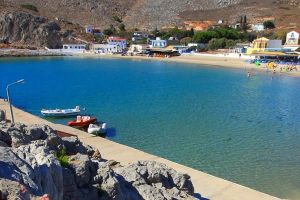
The main beach on the island is at Avlakia, a lovely stretch of golden sand, quickly covered in sunbedded bodies. Day trippers arrive like locusts and snap up all available sunbeds.
They also pack the tavernas and generally make a noisy addition to what would otherwise be a peaceful islet. Even the ferries have been known to queue to tie up to the small quay.
Those boats that can’t find a berth head off to neighbouring Platys which has a similar, but smaller, sandy beach and far fewer trippers.
There are a couple of other beaches, not as attractive but much quieter. One is at Vathy in the north, reached with a 30min walk along a well marked path to a cove of sand and pebbles. Another is at Marathounda to the west, a 45min walk to a small pebble cove. Indeed, the island is so small that nowhere can be more than an hour’s walk in any direction.
Day trippers make up almost all the visitors as there is so little accommodation on the islet. There are rooms to be had above the tavernas and one small store which gets stocked up by the daily boat that leaves Pothia on Kalymnos around 9am each day.
Nearly all the other boats that pull in are taking trippers on daily cruises between Kos and Kalymnos with a short stop both here and at Platys.
Islets near Kalymnos
Telendos
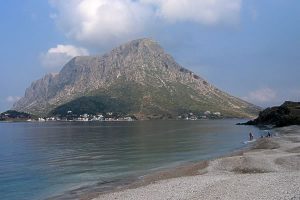
Today Telendos is one of the best reasons for visiting Kalymnos, with a smart new quayside packed with good tavernas and tiny beaches dotted about in the islet’s many coves.
Every hour during the day small caiques take a dozen or so on the 10-minute journey from Myrties jetty to Telendos.
There are no roads on Telendos and no traffic. The wide quayside is paved and a dozen or so tavernas place tables along the shore. It’s a romantic setting and a favourite of couples enjoying evening views across the water to the twinkling lights of Myrties and Massouri
The last ferry leaves around 10.30pm although they run later in the high season if the tavernas look full. A few rooms can be rented here, mostly above the tavernas.
Telendos lives, like Pserimos, in calm rhythms. The kindness of the inhabitants, who are not over sixty, and the harmony of the images will be the best gift for you who are looking for the ultimate relaxation.
On the occasion of your water tour, finally, visit the ruins of Roman and Byzantine times, the rock-carved Roman theater and the fortifications of Historical times in the north of the island.
Pserimos
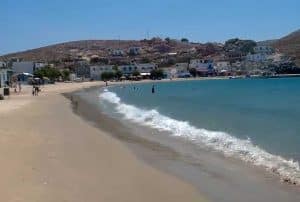
The settlement, built around the small port, is set against a background of olive trees and a pine-tree grove. The miniscule pier plays host every day to numerous boats bringing tourists on day cruise from Kalymnos and Kos. This is when the calmness of the landscape gives way to a busting scene of a thoroughfare, as the port becomes alive.
Sandy bights around the port and further on at Vathy, make of Pserimos a unique destination. Archaeological excavations have unearthed the remnants of an ancient settlement believed by some to have pertained to the ancient municipality of Piraeotae. Westwards there lies the islet of Plati, part of which is a rocky islet of its own.
Pserimos, measuring total 15 square kilometers in surface and with a population of 80, is an ideal place for easygoing, fuss-free holidaymaking, to be cherished by the peripatetic. Its inhabitants’ main activities are stock-breeding, fishing and tourism.
Villages and towns of Kalymnos
Pothia
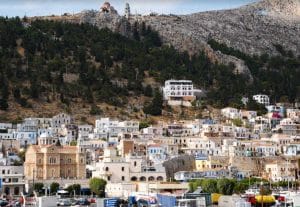
There you will find a densely populated place with taverns, cafes, restaurants, rooms and tourist facilities, while you will be impressed by the traditional white houses with colored windows. And after feeling the pulse of the island, head towards the southwest and Therma, where you will find hot springs with healing properties and continue towards the rest of the settlements.
Argos, Skalia with its cave, the green Panormos with its beautiful beaches, the Myrties opposite the islet of Telendos, the touristic Masouri with its nightlife, which is also a good choice for accommodation, the quiet and remote Emporios, the seaside Vlychadia and beautiful Vathi have a lot to show you about life in Kalymnos.
Vathy
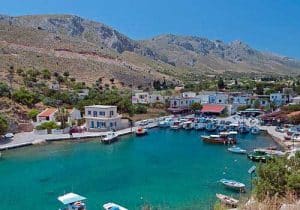
Visitors through road routes or walks can enjoy unique beauties and important archaeological sites. Small sea boats visit the prehistoric Daskalio cave at the entrance to the port of Rina. A few meters from the port of Rina there is a natural aquarium which is a unique attraction. In the port of Rina there is a shipyard as well as a safe mooring for the reception of tourist pleasure boats. In Rina, there are hotels, traditional taverns and cafes offering various culinary delights and traditional foods.
Vlychadia
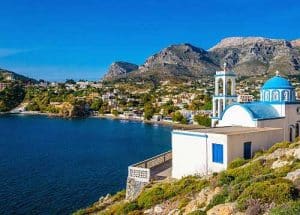
The combination of the bay with the verdant and citrus-filled valley creates a landscape of amazing beauty that many have likened to a fjord. Argos (7 km.) with the most important Byzantine church of Kalymnos, of the Holy Twelve Apostles.
Masouri
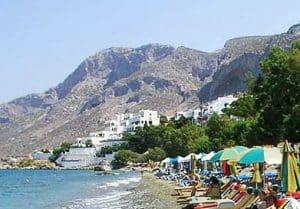
It is considered one of the best beaches of the island with a view of Telendo, crystal clear waters and good organization.
During the tourist season, Masouri attracts with its intense summer rhythms and vibrant nightlife. Imposing cliffs rise around Masouri and it is considered a climbing paradise. There are all kinds of services such as hotels, shops, banks, car and bike rental offices.
Arginontas
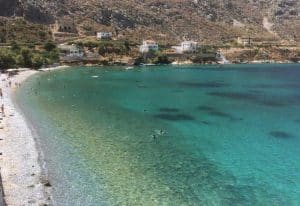
Pack your beach bag, apply your sunscreen and get ready for long dives in the wonderful Aegean waters that surround Kalymnos. For youthful situations head to Kantouni, Linaria, Platy Gialos in Panormos, while in Masouri you will find one of the most popular beaches. You will find shallow waters, suitable for children and shade at Vlychadia beach, about 5 kilometers from Pothia, as well as at Myrties. On the beach of Emporio with its strong winds you will find pebbles and plane trees, as well as many windsurfing, water-skiing, diving etc., while for crystal blue waters, greenery and relaxation you will go to the beach of Arginotas, in the north-west of island.
Panormos
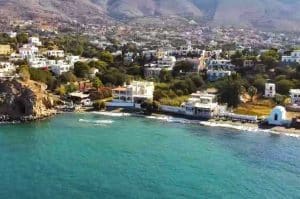
Most people visit Panormos mainly for its beautiful beaches. Kadouni, Linaria and Platys Gialos are the three most beautiful beaches of the settlement. Steep mountain slopes with well-formed routes are ideal for mountaineering and climbing.
A favorite holidaymakers destination, this settlement has been set against a lavishly green background, featuring lace-like waterfront spots, amongst which Kantouni and Linaria.
Panormos lies on the site of what was once the ancient Mesos Dimos (Central Municipality), Damos, as the area is still referred to, to this day. Close to this site there is a location known as Tsoukalario, where findings suggest the existence, in ancient times, of pottery workshops. The ancient settlement of Panormos boasts of 800 dwellers and lies within 5 km distance northwest from the port of Pothia.
Palionisos
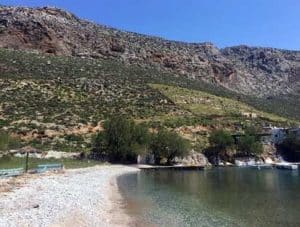
There are also quite a few daily excursions with private speedboats, especially at the weekend, from the neighboring islands. Of course, the visitors of Palionisos are not only coming by the sea. Quite a few people from Kalymnos visit Palionisos with cars and motorbikes
The boats are docked in the bay of Palionisos and its passengers along with their bath, also enjoy the traditional delicacies from the Taverns of the area.
Myrties
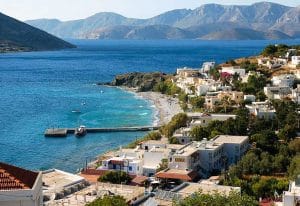
This picturesque, waterfront settlement located at a spot where only a narrow strait separates Kalymnos from the islet of Telendos, a piece of land once forming part of Kalymnos until it split away under the horrible tremors of the earthquake that devastated the region in AD 535.
Small boats connect Myrties to Tenedos several times within the day. Myrties lies at an 8 km distance northwest from Pothia and currently boasts 14 inhabitants.
Diving and snorkeling
Kalymnos is famous for its rich seabed, which attracts diving and snorkelling enthusiasts every year. An ideal destination for this type of diving is Vlychadia, the Therma-Pithari area, the sponge farms in Kastelli and Kambi, as well as the southwestern coast of Telendos, among others. In Kalymnos you will also find diving centers if you need help or are not familiar with the sport.
The most widespread activity on the island, however, is climbing, since it is an island that has made use of its mountainous mass, with easy access to climbing routes, limestone rocks, with sharp points, everything you need for this activity.
On the island you will find 77 climbing fields and if you are interested in doing this activity, try contacting a Climbing School, especially if you are a beginner, attending summer classes. On the island you can also engage in hiking, discovering its mountain paths and its hundreds of walking routes, while you also have the opportunity to explore the island’s caves, such as the Cave of Kefalas, the Cave of the Seven Virgins, the Cave of Skalia , the Hoiromantres Cave etc.
Day trips to Telendos
If you find yourself in Kalymnos, don’t forget to go outside, taking boat trips and visiting the surrounding islands with their beautiful beaches. A breath away from Kalymnos and specifically from Myrties, is the islet of Telendos, where in addition to beautiful beaches, you will find a small picturesque settlement, abundant remains from the late Roman period and of course tavernas for plenty of fresh fish and seafood. Also, from Kalymnos, you can “fly” to Pserimos in about 50 minutes and swim on its isolated sandy beaches.
Beaches
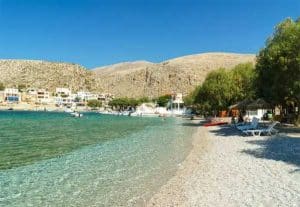
Therma is the closest beach to Pothia, at a distance of 2 km, while Vlychadia essentially consists of two beaches, one sandy and one pebbly. Linaria is considered a family beach, while young people prefer cosmopolitan Kantouni.
Platys Gialos is famous for its black sand and is ideal for fishing, while Emporios is ideal for wind and kite surfing. If you want to be isolated, choose the bay of Arginoton or the beaches of Almyres, Drasonda, Pezonta, Palionisos, Sikati and Petronta which are only accessible by boat.
Myrties beach is located at a distance of 8 kilometers from Pothia to the west of Kalymnos, it is 700 meters long and is pebbly. Its waters are shallow and suitable for children. Opposite is Telendos and every day there are small boats. On the beach there are umbrellas and sunbeds for rent as well as restaurants, cafes and rooms for rent.
Kantouni beach is located in the village of Panormos and we will find it after Elies square. It is a sandy beach famous for its youthful and adolescent atmosphere. Arginota beach is located 16.5 kilometers from Pothia on the northwest side of Kalymnos. A beach with turquoise waters, crystal clear, pebbly and with many trees around.
Food and cuisine
A visit to Kalymnos should definitely include a trip to the island’s traditional Kalymnos food and cuisine. A cuisine that you can taste and enjoy in dozens of restaurants, taverns and ouzo on the island.
In Kalymnos you will taste fresh fish and seafood as well as a wide variety of cooked traditional foods.
In Kalymnos you will enjoy, if nothing else, fresh fish at good prices. Try stuffed squid, dried lobster tail, carp, i.e. salad with salachi meat, spinialo (meze with sea urchins, salachi etc. made by the locals with seawater), octopus meatballs and many other seafood creations.
However, if you want to get away from eating fish, there are plenty of local mouth-watering dishes waiting for you, such as muuri, which is stuffed lamb roasted in a clay pot, dolmades, mirmizeli, i.e. local village bread with barley roll, oil, tomato and cheese and other luscious dishes, everything you need for after the bath. In Pothia you will find taverns for every taste, since most of them are there.
Nightlife
On the island you will not miss drinking and entertainment, even if your day is full of swimming and activities. The island’s evening options are mainly divided between Pothia beach and Masouri, where you can have fun without breaking the bank, since the prices are relatively low.
For a relaxed drink by the sea in Kaduni beach there are two bars very close to each other. The first thing you come across is the bar Rock and Blues, which predisposes you to the music you will hear. Along with the drink you can also play billiards or darts.
If you continue further down, walking on the wooden walkway to avoid the sand, you will find Domus which plays more modern music.The Cantina has tables in an outdoor courtyard next to the beach.
A new entry into the night life of Kalymnos and specifically in Linaria, is Albus bar a very good solution for drinks and sushi.
Ancient monuments and archeological sites
Fortresses
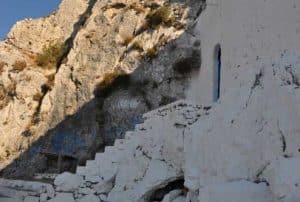
Built on a steep rock and set against a rather austere background, this complex features a church part of which has been carved into the rock. On festive days, most of the cells of the monastery are turned into guestrooms.
Tradition has it that the building of this monastery was financed by a local, a certain Rousso who had, at childhood, been conscripted by force by the Ottomans and later rose to the ranks of pasha under the name of Gul Achmed. It was once as that man wandered through the streets of Kalymnos that the pasha reminisced over his Christian childhood, therefore motivated to look for his long-forgotten father – by then an old man – and to further finance the project of this monastery.
The Fort of Chryssocheria, built with the care of the Knights of Rhodes on the ruins of ancient and Byzantine constructions.
In the area of the village of Emporio, The remains of Kastri, a fort that once rose up on a steep hill. Still visible are parts of the Cyclopean walls and the main look-out tower.
In the surroundings of the village of Massouri, the remains of a Byzantine fortress, located at the site referred to as “the Kasteli“. There is a romantic legend about the handsome prince of Kasteli and his love for the lovely princess having lived across the coast, in the fort of the isled of Telendos.
At Chorio, a Fort built by the Knights of Rhodes as a complement to the Byzantine fortifications already rising on the hill. Interestingly, this fort had been inhabited until the early 18th century. Nine small churches is what currently remains from the complex, scattered over the gray-stone hilltop.
On the islet of Telendos: the vestiges of a Byzantine Fort, within a 10 minute distance by boat and then on foot, on the islet’s west coast. Still visible are parts of the wall as well as the sanctuary of the church of Aghios Constantinos.
Where to stay
Most visitors arrive at the large port of Pothia, the island’s capital and the second biggest town in the Dodecanese after Rhodes. Pothia is a busy, bustling town, sandwiched between two mountains on the hillsides which curve around the bay. There are plenty of hotels and other accommodation as you would expect in a busy port on a major ferry route.
Most holiday accommodation is found along the west coast which has the beach resorts geared to the package holiday market. Visiting rock climbers stay in the beach resorts of Massouri, Armeos and Myrties, as these are located below many of the most popular crags. The resorts have a wide range of accommodation from expensive hotel complexes through to budget hotels, self-catering apartments, villas and rooms to let.
It is recommended to book accommodation in advance especially when visiting Kalymnos in May or October, the most popular months for climbing and the Kalymnos Hoteliers Association has a website
The monasteries of the Evangelist and St Catherine have hostels for visitors. There are no campsites on Kalymnos and casual camping is not encouraged.
Getting around Kalymnos
The two main roads on Kalymnos run along the south coast through Pothia and north-west from Pothia to the west coast resorts. Another small road that runs north-west from the east coast village of Vathi to Stimenia.
Steep bends and narrow roads make driving difficult. The streets of Pothia were resurfaced in 2005 after years of neglect.
Taxis cruise the main route from Pothia to Massouri but disappear around 11pm when the last ferries have pulled in from Telendos. Buses are cheap and punctual, though not very frequent, and you must get a ticket before you board from the local supermarket or kiosk. Kalymnos bus timetables can be found here.
The rugged limestone landscape makes Kalymnos ideal for walkers and rock climbers. In spring, the hillsides are swathed in thyme and oregano making for pleasant aromatic walking and food for the Kalymnos island bees and flavour for the honey on sale in many island shops.
A paved donkey track that leads from Pothia to Vathi is considered one of the best walks in the Greek islands.
How to get to Kalymnos
By air
Kalymnos is connected by air to Eleftherios Venizelos Airport of Athens with daily flights. There is also a connection with the airports of Heraklion Crete, Thessaloniki, Rhodes and Chania.
The airport of Kalymnos is located 10-15 minutes from the capital of the island of Pothia and has outdoor parking as well as infrastructure for people with special needs. Read more about the airport of Kalymnos
By ferry
Kalymnos is on the main Dodecanese ferry route for long and middle-distance traffic so trips to nearby islands like Kos, Leros, Patmos and Samos are not a problem.
The fast catamarans of Dodekanesos Seaways run daily services to and from Kos Town with a crossing time of around 45 minutes.
Blue Star Ferries also has three sailings week from Kos Town harbour with a journey time of about one hour and four sailings on the Piraeus to Kastellorizo route calling at Kalymnos, Kos and Rhodes.
Daily ferry services operate from the small port of Mastichari on the north coast of Kos. ANEK Kalymnos runs car ferries, the ‘Olympios Appollon’ and ‘Olympios Zeus’ while the smaller, faster passengers boat Kalymnos Star travels to Pothia on Kalymnos via the islet of Pserimos. There are several sailings daily but times depend on the season. It also runs services to Samos three times a week and to Astypalia on Monday to Thursday.
The Bodrum Ferryboat runs service from Kalymnos to Bodrum and Turgutries in Turkey with a crossing time of about 75 minutes.
